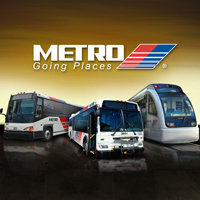This is one of the longer ongoing story lines I’ve followed on this blog.
The red and blue stripes on Metro’s buses and trains soon could be joined by advertisements for Red Lobster and Blue Bell, a nod to the agency’s efforts to seek out new sources of revenue.
Transit officials are considering changes to Metropolitan Transit Authority policies that would allow advertising inside and outside buses and trains, at bus stops and stations, parking garages and perhaps even the station names.
“We’re making our way through it, forming a plan, and then we’ll go from there,” Metro CEO Tom Lambert said, acknowledging he expects staff to recommend paid ads on and in the agency’s buses and trains.
Transit officials initially were poised to approve some of the changes this month, but held back in favor of more discussion. Authority board members and observers said several matters would need to be resolved before any changes can be made, notably the need for clear rules of what Metro will and will not accept and how large ads can be.
“Part of my concern is not so much doing it, but when you mix a bunch of ads it looks awful,” Metro board member Jim Robinson said.
Metro Chairwoman Carrin Patman said officials plan to consider an ad policy as early as next month. If approved, agency staff can begin to solicit proposals from firms interested in overseeing the advertising — essentially selling the space — and then dividing the revenue between the company and Metro.
[…]
Metro does allow certain sponsorships and wraps its own buses and trains for internal marketing efforts. The changes under consideration would open up many avenues of for ads.
“Basically, inside and outside all our assets,” said Debbie Sechler, Metro’s executive vice-president for administration.
Ads could accompany the log-on if Metro offered Wi-Fi, or even the agency’s website, where many riders go for schedule and customer service information.
The goal, Sechler said, would be to use the revenue to improve the system, primarily in enhancements for riders.
Patman said officials are open to ads “in light of our need to look at all conceivable funding sources” as Metro looks to expand bus and rail offerings in city.
Because Metro excludes commercial advertising, companies have been reluctant to discuss how much revenue the system could expect, Sechler said. At a meeting Wednesday, she estimated all types of advertising could generate in excess of $10 million a year, though it is likely an advertising firm handling the marketing of Metro’s buses, trains and shelters would take a portion of that.
Metro’s yearly operating budget is around $700 million.
The decision board members face is whether the financial gain is worth whatever sacrifice could come with paid ads.
“My concern is the difference between what we bring in and what we are obligated to, that may not be enough to justify changing the look of our brand,” board member Lex Frieden said.
We’ve been talking about this since at least 2008, with the most recent mention I can find being in 2015. Previous attempts at this occurred in 2010 and 2012. We have definitely hashed this out, and we have always stopped short. My opinions, for what they are worth:
1. Basically nobody objects to ads inside buses and rail cars, so I have no idea why we aren’t already doing those.
2. People do have opinions about ads on the outside of buses and trains, and I’m fine with everyone who has an opinion getting some input on what the parameters will be for external ads – size, number, placement, what have you.
3. Metro should be very clear about what kind of ads it will allow and reject. There are always controversies whenever there are provocative ads being bought on buses and trains. Having clear and unambiguous standards will help buffer against some of that.
4. The amount of money Metro can make from ads is relatively small compared to its operating budget, but still millions of dollars a year. As the story notes, this can be used to pay for free-fare promotional days, and (my preference) it can be used towards the installation of bus shelters and the repair and improvement of sidewalks around bus stops. Imagine how much of this could have already been done if Metro had taken action to allow ads back in 2008, or 2010, or 2012, or even 2015.
5. In short, do it. Seriously, why are we still talking about this?


I’m all for renting side panel space, but howabout requiring the business you’re allowing to advertise there be a locally owned business, not a national seafood chain or creamery.
Off the top of my head…
Any Ronnie Killen establishment.
Locally owned coffee shop.
Cedar/Onion/Canyon Creek.
etc.
Absolutely agree with Kuff. Yes to ads, and I would sell them to the highest bidders, period. No other restrictions.
Planned Parenthood? Gun show? Strip club? Show me the money.